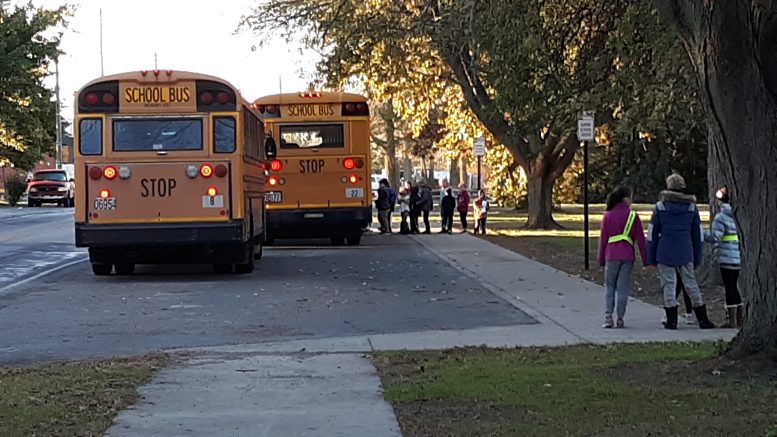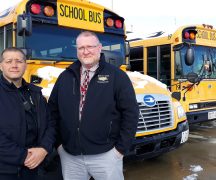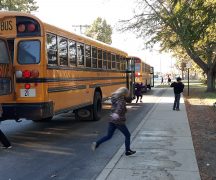By JAN LARSON McLAUGHLIN
BG Independent News
Local bus drivers fear their routes are just accidents waiting to happen. One driver, whose route travels U.S. 20, decided to keep track one year of the vehicles that illegally passed her bus when it was stopped for students.
“I quit counting at 77,” she said.
Bowling Green school bus drivers have reported 44 motorists illegally passing so far this year. Perrysburg has reported 38.
“It’s just a blatant disregard for the law,” one bus driver said.
State Senator Randy Gardner, R-Bowling Green, met on Friday with local school superintendents, school transportation directors and bus drivers at Bowling Green High School.
Gardner had heard concerns about drivers illegally passing stopped buses, and decided to talk to the people who deal with it daily.
“We ought to talk to the people on the roads,” he said.

State Senator Randy Gardner
Attending the meeting were representatives of Bowling Green, Eastwood, Elmwood, Otsego, Lake, Perrysburg, Rossford and Anthony Wayne school districts. They discussed changes that might make drivers more likely to comply with the law – stiffer penalties, cameras catching them in the act, or more education.
School buses are a safe mode of transportation, according to the National Highway Safety Board, Gardner said. School buses log about 5.7 billion miles a year, and are 50 to 70 times safer than other forms of transportation, he said.
“It’s the safest way to transfer your children to school and home again,” Gardner said.
However, defiant and distracted drivers sharing the road are posing risks for buses.
“Obviously, it’s a nationwide problem. Everybody here knows it,” said Toby Snow, transportation director for Bowling Green City Schools.
Bus drivers talked about motorists that speed up to pass buses preparing to stop.
“They don’t want to wait, so they increase their speed and run your yellow lights,” one driver said.
Another driver said it’s almost a daily problem – and she’s too busy watching the road and children to identify the offending vehicles. “I don’t have time to look at that license plate.”
The offenders range in age from 16 to 96. They pass stopped buses on sunny days and snowy days.
“Motorists are just not following the law,” Bowling Green Superintendent Francis Scruci said.

Gardner meets with bus drivers.
Gardner, the administrators and the drivers discussed ways to reduce the incidents – whether through equipping the buses with more cameras and lights, passing legislation that would increase penalties for repeat offenders, or doing more to educate drivers.
So far, Bowling Green is the only local district that has installed the exterior cameras on its buses.
The law requires drivers to stop for school buses when the red lights are turned on and the stop sign is extended on the side of the bus. Vehicles are required to stop at least 10 feet away from the bus.
The bus drivers put yellow lights on first to warn drivers that a bus stop is approaching.
If the bus is on a four-lane road, just the vehicles headed the same direction as the bus are required to stop.
Bus drivers reporting traffic offenders are asked to identify the vehicle, license plate and give a description of the driver passing them illegally. But that is asking too much for drivers who are also watching a busload of children, Snow said.
“It’s almost impossible,” he said.
So the cameras help do the job. They are mounted at an angle so they catch license plates of passing vehicles.
“We’ve had them catching them as fast as 50 mph,” Snow said. And they are able to capture license plates in daylight or darkness.
“The driver can now concentrate on the children,” he said.
The costs for the cameras vary, with districts being quoted prices between $250 and $900 per camera.
Wisconsin makes the cameras mandatory equipment on all school buses.
“I wouldn’t want to mandate it and just tell schools – it’s your responsibility,” Gardner said.
Gardner talked about the possibility of setting up a grant program to help districts purchase the bus cameras.
“This is about as important as it gets when it comes to safety,” he said.
But Bowling Green bus driver Jim Elliott cautioned that while the cameras are helpful, their impact is limited.
“Cameras don’t make the kids any safer,” he said. “They aid in the prosecution of drivers.”
The group also discussed the possibility of adding more safety lighting to buses, or “stop” arms that extend all the way across the neighboring lane.
“How many more lights can we put on the buses,” one driver asked.
Some felt toughening laws for those illegally passing buses was also a good response. Currently, a driver passing a bus with its red lights on is subject to a fine up to $500, plus may have their license suspended. But those maximum penalties are often decreased, and there are no automatic steps for multiple offenses.
House Bill 646 has been proposed in Ohio that would heighten penalties for motorists with second offenses of illegally passing school buses. The bill would increase the fine to $1,000, and would allow license suspension up to three years.
“A lot of it’s about education of the public,” Snow said.
“People need to quit being distracted, quit being in such a hurry,” one driver said.
Signage could be added to the roads with heavy bus traffic – but would that help, they wondered.
Gardner said he hoped to come up with some type of comprehensive legislation that could quickly make it through the State Assembly.



